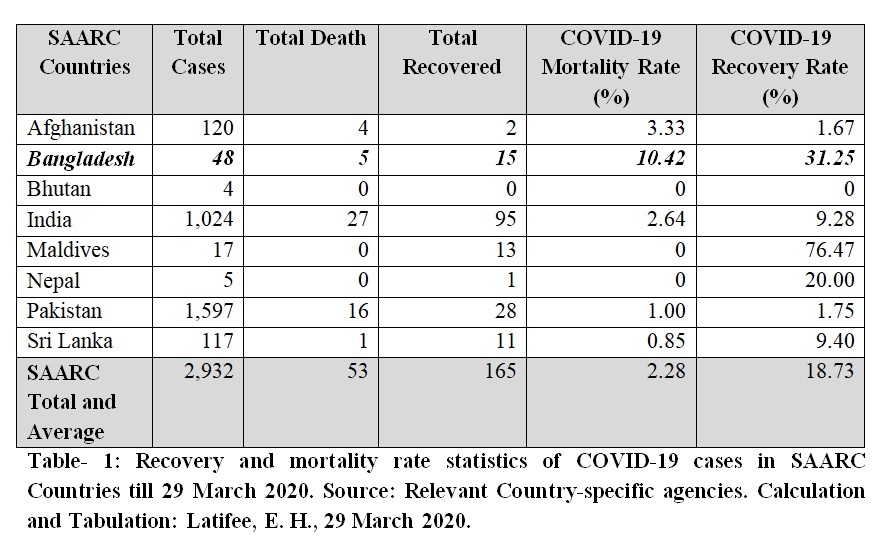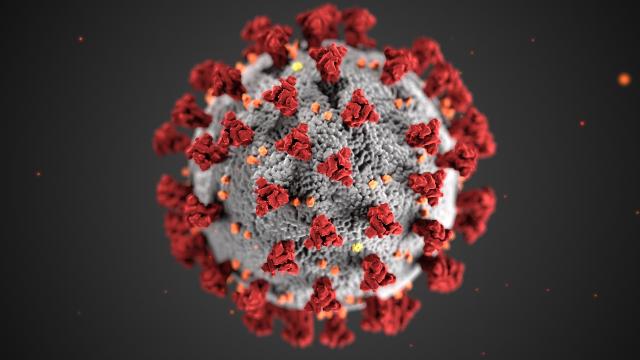Enamul Hafiz Latifee writes,
The COVID-19 emerged during December 2019 at Wuhan City, Hubei Province of China has infected more than 722,900 people claiming 34,200 lives so far till 29 March 2020 just after causing first death on 11 January 2020, in a very short time, literally within 2 months 18 days only and counting more at every single second, spreading worldwide at an exponential rate. The trace to COVID-19 takes us on 31 December 2019, when the World Health Organization (WHO) was alerted to a group of pneumonia patients in China. After one week, on 07 January 2020, the Chinese authority confirmed identifying a new type of Coronavirus that caused pneumonia and named it as 2019‑nCoV. On 11 February 2020, the WHO named it COVID-19 and on 11 March 2020, WHO Director-General, Dr. Tedros Adhanom Ghebreyesus characterized COVID-19 as a pandemic as it infected 118,000 cases in 114 countries, and 4,291 people lost their lives till then.
Bangladesh, the world’s 8th largest populated country with 165.55 million people having a population density of 1,121.50 per square kilometer, officially reported its first three COVID-19 cases on 08 March 2020 by Professor Dr. Meerjady Sabrina Flora, Director, Institute of Epidemiology, Disease Control and Research (IEDCR). Since then, IEDCR and other organizations performed the Polymerase Chain Reaction (PCR) test on 1,076 individuals ranging from 50 to 110 persons daily and found forty-eight COVID-19 positive people among whom 15 had recovered and 5 had died, surprisingly enough, there was no single COVID-19 case had been found on 28 and 29 March 2020, raising a question over the coverage of tests being conducted.
However, the print news media of Bangladesh are constantly reporting few more deaths everyday terming them showing COVID-19 like symptoms during their deaths, but these claims are of uncertainty as IEDCR was not able to test their blood samples at many occurrences. Meanwhile, the WHO has classified Bangladesh’s COVID-19 spread as “Locally Transmitted”.
Realizing the urgency of preparedness and responding to the pandemic, Directorate General of Health Services (DGHS) of Bangladesh has drafted and published 17 Guidelines so far, covering national preparedness, individual-level prevention procedures, home care of COVID-19 mild symptoms showing persons, standard operating procedures for hospitals, patients’ biological and other waste handlings, and many other fundamental aspects. However, it is worrisome to observe that the mortality rate in Bangladesh is 10.42% due to COVID-19 that is terribly higher than any other SAARC Countries, followed by Afghanistan that has COVID-19 mortality rate at 3.33% till today (Table- 1).

On 25 March 2020, while addressing the nation on the occasion of the Independence and National Day, Bangladesh Prime Minister Sheikh Hasina made the plea by saying, “We won in 1971 against our enemy by standing shoulder to shoulder. Fighting Coronavirus is also a war and in this war, your responsibility is to stay home. If the Almighty wants, we shall win the war with everyone’s efforts”. Riding on the exact directions provided, Bangladesh should take the WHO’s extensively explained 8 major pillars at its publication “Operational Planning Guidelines To Support Country Preparedness And Response” very seriously (Figure- 1).

Furthermore, the WHO has segregated these eight major pillars into 3 levels of priority steps and actions, i.e., Basic Level, Developing Level, and Sustainable Level. At the Basic Level, a country is suggested to map current capabilities and establish actions based on pre-existing plans, while, at the Developing Level, a country is recommended to broaden the scope of actions and deploy additional resources, and to be at the Sustainable Level, the country should gain the ability of systematic monitoring and adjusting readiness and response plans as appropriate. Revisiting the immediate steps suggested by the WHO in Operational Planning Guidelines and Bangladesh’s current developments on Coronavirus, the following recommendations are made to sharpen the country’s strategies in this battle with COVID-19.
Testing Facilities to be made available up to the District Level
Along with IEDCR, 3 other organizations- Institute of Public Health (IPH), Dhaka Shishu Hospital (DSH), and Bangladesh Institute of Tropical and Infectious Diseases (BITID) have started testing the blood samples for COVID-19 detection very recently. However, as 3 of the testing facilities are located in Dhaka and 1 in Chittagong, there is a very high possibility that many COVID-19 infected persons may go undetected creating threats further on the entire population. This may also cause failure in harnessing positive results through the declared partial lockdown in the country from 26 March to 04 April 2020, as the existing institutional resources of these 4 organizations may not be enough to offer country-wide testing services more frequently.
In such a case, South Korean ready-experience of setting up “Phone Booth” look-like quick COVID-19 examination facilities taking only 7 minutes to perform the whole examination process can be the light of hope for Bangladesh. Addressing this criticality, DGHS can consider seeking the cooperation of Embassy of the Republic of Korea to Bangladesh for setting up this COVID-19 examining Phone Booths here at 64 districts in Bangladesh, the government can also work on transferring the know-how for enabling more human resources for operating these facilities.
Readying the Upazilla level Hospitals with Isolation Units
It has been learned from the “National Preparedness and Response Plan for COVID-19, Bangladesh” that 3 hospitals of Dhaka city- Kurmitola, Kuwait Moitree, and IDH, have been selected for managing the patients in isolation, and around 500 hospitals will be prepared for initial care of the COVID-19 patients with mild illness. However, as the population density of Bangladesh is one of the highest in the world, so the existing central isolation system at the national or district level would not give any edge.
In the way of bringing a COVID-19 infected individual from a corner of the country to the centre would create scopes of spreading viruses at many layers of transportations. In addition, all the 500 hospitals should be readied at the quickest pace with Ventilators and sufficient 3 layered Personal Protective Equipments (PPEs) following the practices of China could be made available for frontline Doctors, Nurses, and other Health Workers.
Incentivizing the Manufacturers to make Essentials for preventing the spread of COVID-19
On 27 March 2020, The United States President Donald Trump has ordered General Motors to make ventilators for Coronavirus patients, on the other side, on 20 March 2020, Prime Minister of Canada Justin Trudeau had launched Canada’s Plan to Mobilize Industry to fight COVID-19, that orients new measures directly supporting businesses to rapidly scale up production or retool their manufacturing lines to develop critical health and safety supplies and equipment, including sanitization products, personal protective equipment, diagnostic and testing products, and disease tracking technologies in Canada that will support the battle against Coronavirus.
It is praiseworthy that, Bangladesh Prime Minister Sheikh Hasina has also announced Taka 5,000 crore incentive package for export-oriented businesses that could only be disbursed in the form of wages and salaries for workers and staffs. Similarly, Bangladesh Government may also think of offering stimulus package for mobilizing the manufacturing hubs in making ventilators, face masks and shields, hand gloves, sanitizers, PPEs, testing kits, etc. leaving no scope for scarcity of these essentials that can be seen in the market, home, and hospital.
Strictly monitoring the movement of Quarantined Individuals
Till 29 March 2020, Bangladesh has quarantined 53,442 people among whom 24,959 individuals have already obtained release notes from the authority. But, the news media constantly posted in the last several days that home quarantined people at many places are going free and visiting relatives’ houses, markets, and religious places, crafting increasing threats for localities. Community-level awareness building program has to be launched immediately followed by a strict monitoring system enacted by the local police force to enable quarantine as a proper measure to slow down the spread of COVID-19.
The entire world is now at the stake of uncertainty, and the people of Bangladesh have the common belief that this critical situation will not last long if steps taken by the government are synched with the private sector initiatives, propelled with home-grown technologies, and communicated with the communities at right time.
Enamul Hafiz Latifee is Deputy Secretary, Dhaka Chamber of Commerce and Industry (DCCI). Can be reached at: ehlatifee@dhakachamber.com. Views expressed here are not from the organization that the author represents.
